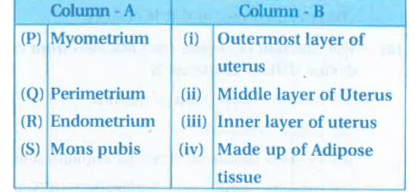A woman 'S' Is in uremia stage. Therefore…………..
(i) Legs and hands are swollen
(ii) Body is accumulated with water and wastes
(iii) Weakness and tiredness
(iv) No harm to kidneysSolution in Telugu
All are correct
Only (iv) is correct
only (iv) is wrong
None of the above
Step by step video & image solution for A woman 'S' Is in uremia stage. Therefore………….. (i) Legs and hands are swollen (ii) Body is accumulated with water and wastes (iii) Weakness and tiredness (iv) No harm to kidneys by Biology experts to help you in doubts & scoring excellent marks in Class 10 exams.
Topper's Solved these Questions
- BOOK - BEYOND PUBLICATIONCHAPTER - EXCRETION-THE WASTAGE DISPOSING SYSTEMEXERCISE - EXERCISE156videos
EXCRETION-THE WASTAGE DISPOSING SYSTEM
- BOOK - BEYOND PUBLICATIONCHAPTER - COORDINATIONS IN LIFE PROCESSESEXERCISE - EXERCISE57videos
COORDINATIONS IN LIFE PROCESSES
- BOOK - BEYOND PUBLICATIONCHAPTER - HEREDITY - FROM PARENT TO PROGENYEXERCISE - EXERCISE167videos
HEREDITY - FROM PARENT TO PROGENY
Similar Questions
Earthworm excretes its waste material through .................. .
03:03View SolutionIn which of the following situations you can taste quickly ?
04:35View SolutionWhat colour of stem would you expect in their F1 progeny ?
02:35View SolutionThe char5acteristic(s) common to urea, uric acidn and ammonia is/are
(i). Theya re nitrogenous wastes.
(ii). They all need very largwe amount of water for excretion.
(iii). They are all equally toxic.
(iv). They are produced in the kidneys03:54View SolutionMatch column I with column II and select the correct option from the codes given below ltBrgt Column IColumn IIA. Uremia(i). Ketone bodies in urineB. Ketonuria(ii). Artificial kidneyC. Glycosuria(iii). Glucose in urineD. Blood dialyser(iv). Accumulation of urea in blood
01:34View SolutionMatch the columns and choose the correct options {:(,I,,II),((p),"e-waste",(i),"Waste clothing"),((q),"Biodegradable waste",(ii),"Dirt"),((r),"Inert waste",(iii),"Green waste"),((s),"Composite waste",(iv),"Irreparable waste"):}
04:14View Solutionwhat is the BOD of a weak organic waste water body?
08:35View SolutionWhich is not a physical method of waste water treatment. (i) Floatation (ii) Filtration (iii) Phyto remediation (iv) Oxidation
04:52View SolutionList the most important feature of the following stages : (i) S-phase, (ii) Zygotene, (iii) Pachytene: (iv) Anaphase-I
04:35View SolutionA feature that urea, uric acid and ammonia all have (i) They are nitrogenous waste materials. (ii) Higher levels of water are required for the emission of all these. (iii) They are all equally toxic. (iv) They are produced in the kidneys.
05:49View Solutionসমসংস্থ অঙ্গের উদাহরণ হল- [i]মানুষের অ্যাপেন্ডিক্স ও চোখ [ii] ঘোড়ার পা ও মানুষের হাত [iii]মানুষের চোখ ও কসিক্স [iv]মানুষের হাত ও তিমির ডানা
02:06View SolutionMatch Column A with Column B

(A) (P-i), (Q-ii), (R-iv), (S-iii)
(B) (P-ii), (Q-i), (R-iii), (S-iv)
(C) (P-ii), (Q-iii), (R-iv), (S-i)
(D) (P-iv), (Q-iii), (R-ii), (S-i)02:26View SolutionMatch the following (A) (i-P), (ii-S), (iii-R), (iv-Q) (B) (i-Q), (ii-S), (iii-P), (iv-R) (C) (i-Q), (ii-P), (iii-R), (iv-S) (D) (i-P), (ii-R), (iii-Q), (iv-S)
01:22View SolutionThe characteristic(s) common to urea, uric acid and ammonia is/are (i). They are nitrogenous wastes. (ii). They all need very large amount of water for excretion. (iii). They are all equally toxic. (iv). They are produced in the kidneys
03:10View SolutionMatch column I with column II and select the correct option from the codes given below ltBrgt Column IColumn IIA. Uremia(i). Ketone bodies in urineB. Ketonuria(ii). Artificial kidneyC. Glycosuria(iii). Glucose in urineD. Blood dialyser(iv). Accumulation of urea in blood
View Solution

